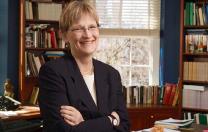The search for Harvard’s twenty-eighth president began under difficult circumstances. Lawrence H. Summers’s resignation on February 21, 2006, ended his presidency far sooner than had been expected. The Corporation, whose members (excluding the president) organize such searches, had to begin one quickly, under heightened scrutiny, knowing that the University would be led, perhaps for a prolonged period, by an interim president. Moreover, the Corporation itself was freshly constituted: Senior Fellow James R. Houghton’s service began in 1995, but all the other members were appointed after Summers took office in 2001; the newest, Patricia A. King, elected in December 2005, did not formally join the Corporation until the following May.
The search committee (including three Overseers) proceeded in customary secrecy, prompting the equally customary news leaks, particularly after the entire 30-member Board of Overseers was briefed in December on a list of candidates that included many leaders of research universities: presidents Lawrence Bacow (Tufts), Lee Bollinger (Columbia), Richard Brodhead (Duke), Amy Gutmann (Penn), Ruth Simmons (Brown), and Shirley Tilghman (Princeton), Stanford provost John Etchemendy, and University of Cambridge vice-chancellor Alison Richard. Because all those candidates were recent appointees, and several were involved with major capital campaigns, their availability and interest seemed slight. Several said they were not candidates. Much attention focused on Nobel laureate Thomas R. Cech, a chemist at the University of Colorado and president of the Howard Hughes Medical Institute; his expertise and the institute’s recent activities (see “The Janelia Experiment,” January-February, page 53) appeared relevant to Harvard’s plans for the sciences in Allston. Internal prospects included Elena Kagan, Harvard Law School dean since 2003; Provost Steven E. Hyman, a neuroscientist; and historian Drew Gilpin Faust, Radcliffe Institute dean since 2001.
Cech revealed that he had indeed been a serious contender when he called the Crimson on the morning of January 31 to disclose that he had “withdrawn my name.” In retrospect, that should not have been a surprise: he had expressed reluctance to give up his laboratory group, had not done any fundraising, and had not been an administrator (apart from his institute duties).
After a further flurry of external speculation, the search committee quickly came to consensus. The Corporation voted to elect Faust, and sought the Overseers’ consent, on February 11.
Beyond selecting Harvard’s first woman president, this search set other precedents by chartering formal faculty and student advisory bodies, and by extensive outreach to alumni (see “Precedent-Setting Presidential Search,” May-June 2006, page 66).
Overseer Frances D. Fergusson, a member of the search committee, said the student advisory group “gave us a very comprehensive understanding of how each school was perceived by its students, and of the major challenges a new president would face,” and credited it with helping her “grasp both the complexity and nuances of Harvard’s radically decentralized structure.” Fergusson credited the faculty advisers with “invaluable” input—“both in their concrete suggestions and their broad-reaching perspectives about Harvard’s future.” Pforzheimer University Professor Sidney Verba, who led the faculty group, said this “more structured way” of involving professors (who have been consulted individually in past searches, without the opportunity to test one another’s opinions) was mutually productive. The faculty members, he noted, not only helped refine search criteria, they also know Harvard and have contacts throughout academia, and so could sound out names for the search committee and render “lots of candid assessments” not available otherwise.
James Houghton said both advisory committees “worked extremely well.…We tested all sorts of ideas with them.” (Alumni contacts had to be handled differently, through travel to meet groups around the world.) The new channels yielded a “better answer than we could have had, had we not done this exercise.” His conclusion: “I would be very strongly in favor” of using a similar process in future searches.







